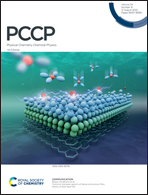Enhanced photoluminescence stability and internal defect evolution of the all-inorganic lead-free CsEuCl3 perovskite nanocrystals†
Abstract
Perovskite materials are prominent candidates for many high-performance optoelectronic devices. The rare-earth lead-free CsEuCl3 perovskite nanocrystals are extremely unstable, which makes it very difficult to study their physicochemical properties and applications. Herein, we improved the stability of rare-earth based CsEuCl3 nanocrystals by employing a silica-coating for the first time. Simultaneously, the naturally formed “hollow” regions with an obviously blue-shifted PL emission were first observed inside the CsEuCl3 nanocrystals during the period of storage. Density functional theory (DFT) calculations showed that the formed “hollow” regions are due to the internal defect evolution in the perovskite lattice, which is also responsible for the increase of the bandgap and the blue-shift of emission. Additionally, the rapid decline of luminescence is probably due to the nanocrystals’ final cracking with the expansion of the “hollow” regions. This work helps to understand the relationship between defects and luminescence properties, and provides guidance for the design of more stable lead-free perovskite nanocrystals.



 Please wait while we load your content...
Please wait while we load your content...